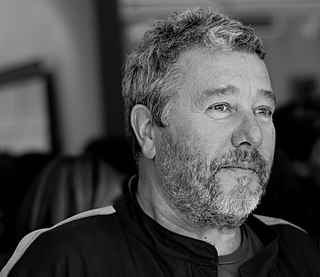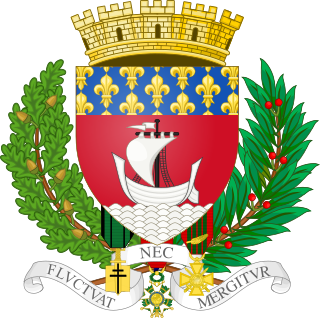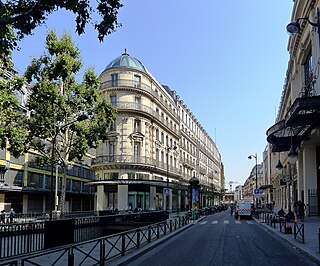
The Hôtel des Invalides, commonly called Les Invalides, is a complex of buildings in the 7th arrondissement of Paris, France, containing museums and monuments, all relating to the military history of France, as well as a hospital and an Old Soldiers' retirement home, the building's original purpose. The buildings house the Musée de l'Armée, the military museum of the Army of France, the Musée des Plans-Reliefs, and the Musée d'Histoire Contemporaine. The complex also includes the former hospital chapel, now the national cathedral of the French military, and the adjacent former Royal Chapel known as the Dôme des Invalides, the tallest church building in Paris at a height of 107 meters. The latter has been converted into a shrine of some of France's leading military figures, most notably the tomb of Napoleon.

Philippe Starck is a French industrial architect and designer known for his wide range of designs, including interior design, architecture, household objects, furniture, boats and other vehicles. His most popular pieces were made in the 1980s and the 1990s.

The Tuileries Palace was a royal and imperial palace in Paris which stood on the right bank of the Seine, directly in front of the Louvre Palace. It was the Parisian residence of most French monarchs, from Henry IV to Napoleon III, until it was burned by the Paris Commune in 1871.

The Monnaie de Paris is a government-owned institution responsible for producing France's coins. Founded in AD 864 with the Edict of Pistres, it is the oldest continuously running minting institution and one of the oldest extant companies in the world.

Meaux is a commune on the river Marne in the Seine-et-Marne department in the Île-de-France region in the metropolitan area of Paris, France. It is 41.1 km (25.5 mi) east-northeast of the centre of Paris.

The Palais-Royal is a former French royal palace located on Rue Saint-Honoré in the 1st arrondissement of Paris. The screened entrance court faces the Place du Palais-Royal, opposite the Louvre. Originally called the Palais-Cardinal, it was built for Cardinal Richelieu from about 1633 to 1639 by architect Jacques Lemercier. Richelieu bequeathed it to Louis XIII, before Louis XIV gave it to his younger brother, Philippe I, Duke of Orléans. As the succeeding Dukes of Orléans made such extensive alterations over the years, almost nothing remains of Lemercier's original design.

JCDecaux Group is a multinational corporation focused on outdoor advertising. As of 2016, it is the largest company in its sector worldwide with adverts on 140.000 bus stops and 145 airports. The company is headquartered in Neuilly-sur-Seine, near Paris, France.

The Château de Bagatelle in Paris is a small Neoclassical-style château with several French formal gardens, a rose garden and an orangerie. It is set on 59 acres of grounds in French landscape style within the Bois de Boulogne, which is located in the 16th arrondissement of Paris.

Groupe ADP, formerly Aéroports de Paris or ADP, is an international airport operator based in Paris (France). Groupe ADP owns and manages Parisian international airports Charles de Gaulle Airport, Orly Airport and Le Bourget Airport, all gathered under the brand Paris Aéroport since 2016.

The City of Paris Dry Goods Company was one of San Francisco's important department stores from 1850 to 1976, located diagonally opposite Union Square. In the mid-20th century, it opened a few branches in other cities of the Bay Area. The main San Francisco store was demolished in 1980 after a lengthy preservation fight to build a new Neiman Marcus, but the store's original rotunda and glass dome were preserved and incorporated into the new design.

The Carlingue were French auxiliaries who worked for the Gestapo, Sicherheitsdienst and Geheime Feldpolizei during the German occupation of France in the Second World War.

The coat of arms of Paris, or simply the Blazon of Paris, shows a silver sailing ship on waves of the sea in a red field, with a chief showing the Royal emblem of gold-on-blue fleur-de-lis. Originally introduced in the 14th century, its current form dates to 1853. The city motto is Fluctuat nec mergitur. The traditional colors of the city of Paris are red and blue.

Oscar Castro Ramírez,, was a Chilean playwright, actor and director of the Aleph Theater.

The Église réformée de l'Oratoire du Louvre, is an historic Protestant church located at 145 rue Saint-Honoré – 160 rue de Rivoli in the 1st arrondissement of Paris, across the street from the Louvre. It was founded as a Catholic church in 1611, became the royal chapel of France and under Louis XIII, and then became a Protestant Church under Napoleon I in 1811. It is now a member of the United Protestant Church of France.

After the French lifted the siege of Orléans and won a decisive victory at the Battle of Patay, the English and Burgundians no longer posed a threat. Joan of Arc convinced the Dauphin Charles to go to Reims for his coronation. Successfully marching their army though the heart of territory held by the hostile Burgundians solidified the Dauphin’s regrasp of the throne of France. He had been disinherited from it through the Treaty of Troyes.
The style of architecture and design under King Louis Philippe I (1830–1848) was a more eclectic development of French neoclassicism, incorporating elements of neo-Gothic and other styles. It was the first French decorative style imposed not by royalty, but by the tastes of the growing French upper class. In painting, neoclassicism and romanticism contended to become the dominant style. In literature and music, France had a golden age, as the home of Frédéric Chopin, Franz Liszt, Victor Hugo, Honoré de Balzac, and other major poets and artists.

Madeleine Zillhardt was a French artist, writer, decorator and painter. Her life and career are linked to another artist, the German-Swiss painter Louise Catherine Breslau, of whom she was the companion, the muse and the inspirer. They lived together for more than forty years, and their lives turned towards the arts. She was the sister of painter Jenny Zillhardt.
Ching-Lien Wu is a French-Taiwanese choir director and choral conductor.

Notre-Dame-de-la-Compassion is a Roman Catholic Church located on Place du Général Koenig in the 17th arrondissement in Paris. It was originally built in 1842–43 as a memorial chapel to Ferdinand Philippe, Duke of Orléans, the heir to King Louis-Philippe of France, who was killed in a road accident in 1842. It was built in the Neo-Byzantine style, with elements of Gothic, Baroque and other styles, and was originally called the Chapelle Royale Saint-Ferdinand. In 1970 it was moved stone by stone from its original location a short distance away to make space for the new Palais des Congrès. It became a parish church in 1993. Its notable decoration includes stained glass windows designed by Jean-Auguste-Dominique Ingres, and sculpture by Henri de Triqueti. It was designated a French historic monument in 1929.

The Rue du Pont-Neuf is a street in the 1st arrondissement of Paris, France, shared between Les Halles to the north and Quartier Saint-Germain-l'Auxerrois to the south. It was pierced in the second half of the 19th century. It bears this name because it leads to the Pont Neuf.



















